

Compact Muon Solenoid
LHC, CERN
| CMS-B2G-20-007 ; CERN-EP-2021-226 | ||
| Search for heavy resonances decaying to a pair of Lorentz-boosted Higgs bosons in final states with leptons and a bottom quark pair at $\sqrt{s} = $ 13 TeV | ||
| CMS Collaboration | ||
| 6 December 2021 | ||
| JHEP 05 (2022) 005 | ||
| Abstract: A search for new heavy resonances decaying to a pair of Higgs bosons (HH) in proton-proton collisions at a center-of-mass energy of 13 TeV is presented. Data were collected with the CMS detector at the LHC in 2016-2018, corresponding to an integrated luminosity of 138 fb$^{-1}$. Resonances with a mass between 0.8 and 4.5 TeV are considered using events in which one Higgs boson decays into a bottom quark pair and the other into final states with either one or two charged leptons. Specifically, the single-lepton decay channel HH $\to$ $\mathrm{b\bar{b}}$WW$^*$ $\to$ $\mathrm{b\bar{b}}\ell\nu q\bar{q}'$ and the dilepton decay channels HH $\to$ $\mathrm{b\bar{b}}$WW$^*$ $\to$ $\mathrm{b\bar{b}}\ell\nu \ell\nu$ and HH $\to$ $\mathrm{b\bar{b}}\tau\tau$ $\to$ $\mathrm{b\bar{b}}\ell\nu\nu \ell\nu\nu$ are examined, where $\ell$ in the final state corresponds to an electron or muon. The signal is extracted using a two-dimensional maximum likelihood fit of the H $\to$ $\mathrm{b\bar{b}}$ jet mass and HH invariant mass distributions. No significant excess above the standard model expectation is observed in data. Model-independent exclusion limits are placed on the product of the cross section and branching fraction for narrow spin-0 and spin-2 massive bosons decaying to HH. The results are also interpreted in the context of radion and bulk graviton production in models with a warped extra spatial dimension. The results provide the most stringent limits to date for X $\to$ HH signatures with final-state leptons and at some masses provide the most sensitive limits of all X $\to$ HH searches. | ||
| Links: e-print arXiv:2112.03161 [hep-ex] (PDF) ; CDS record ; inSPIRE record ; HepData record ; Physics Briefing ; CADI line (restricted) ; | ||
| Figures | |
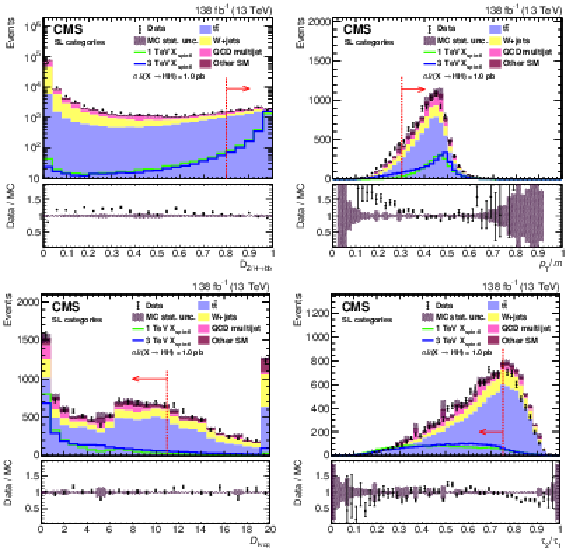
png pdf |
Figure 1:
Single-lepton channel observables: distributions are shown for data (points), pre-fit simulated SM processes (filled histograms), and simulated signal (solid lines). The statistical uncertainty in the simulated sample is shown as the hatched band. Spin-0 signals for ${m_{\mathrm{X}}}$ of 1.0 and 3.0 TeV are displayed. The rightmost bin in the ${D_{\ell \nu {{\mathrm{q} \mathrm{\bar{q}}} ^\prime}}}$ plot contains the overflow events. For both signal models, $\sigma \mathcal {B} (\mathrm{X} \to {\mathrm{H} \mathrm{H}})$ is set to 1.0 pb. The lower panels of each plot show the ratio of the data to the sum of all background processes. The red dashed line and arrow indicate the selected region of the variable of interest. |

png pdf |
Figure 1-a:
Single-lepton channel observables: distributions are shown for data (points), pre-fit simulated SM processes (filled histograms), and simulated signal (solid lines). The statistical uncertainty in the simulated sample is shown as the hatched band. Spin-0 signals for ${m_{\mathrm{X}}}$ of 1.0 and 3.0 TeV are displayed. The rightmost bin in the ${D_{\ell \nu {{\mathrm{q} \mathrm{\bar{q}}} ^\prime}}}$ plot contains the overflow events. For both signal models, $\sigma \mathcal {B} (\mathrm{X} \to {\mathrm{H} \mathrm{H}})$ is set to 1.0 pb. The lower panels of each plot show the ratio of the data to the sum of all background processes. The red dashed line and arrow indicate the selected region of the variable of interest. |
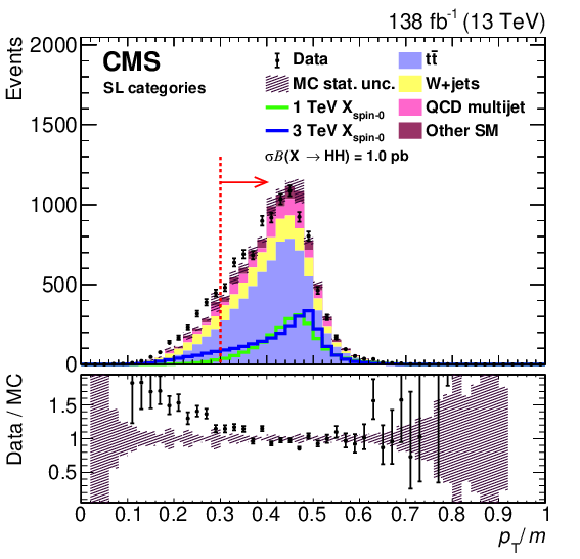
png pdf |
Figure 1-b:
Single-lepton channel observables: distributions are shown for data (points), pre-fit simulated SM processes (filled histograms), and simulated signal (solid lines). The statistical uncertainty in the simulated sample is shown as the hatched band. Spin-0 signals for ${m_{\mathrm{X}}}$ of 1.0 and 3.0 TeV are displayed. The rightmost bin in the ${D_{\ell \nu {{\mathrm{q} \mathrm{\bar{q}}} ^\prime}}}$ plot contains the overflow events. For both signal models, $\sigma \mathcal {B} (\mathrm{X} \to {\mathrm{H} \mathrm{H}})$ is set to 1.0 pb. The lower panels of each plot show the ratio of the data to the sum of all background processes. The red dashed line and arrow indicate the selected region of the variable of interest. |

png pdf |
Figure 1-c:
Single-lepton channel observables: distributions are shown for data (points), pre-fit simulated SM processes (filled histograms), and simulated signal (solid lines). The statistical uncertainty in the simulated sample is shown as the hatched band. Spin-0 signals for ${m_{\mathrm{X}}}$ of 1.0 and 3.0 TeV are displayed. The rightmost bin in the ${D_{\ell \nu {{\mathrm{q} \mathrm{\bar{q}}} ^\prime}}}$ plot contains the overflow events. For both signal models, $\sigma \mathcal {B} (\mathrm{X} \to {\mathrm{H} \mathrm{H}})$ is set to 1.0 pb. The lower panels of each plot show the ratio of the data to the sum of all background processes. The red dashed line and arrow indicate the selected region of the variable of interest. |

png pdf |
Figure 1-d:
Single-lepton channel observables: distributions are shown for data (points), pre-fit simulated SM processes (filled histograms), and simulated signal (solid lines). The statistical uncertainty in the simulated sample is shown as the hatched band. Spin-0 signals for ${m_{\mathrm{X}}}$ of 1.0 and 3.0 TeV are displayed. The rightmost bin in the ${D_{\ell \nu {{\mathrm{q} \mathrm{\bar{q}}} ^\prime}}}$ plot contains the overflow events. For both signal models, $\sigma \mathcal {B} (\mathrm{X} \to {\mathrm{H} \mathrm{H}})$ is set to 1.0 pb. The lower panels of each plot show the ratio of the data to the sum of all background processes. The red dashed line and arrow indicate the selected region of the variable of interest. |
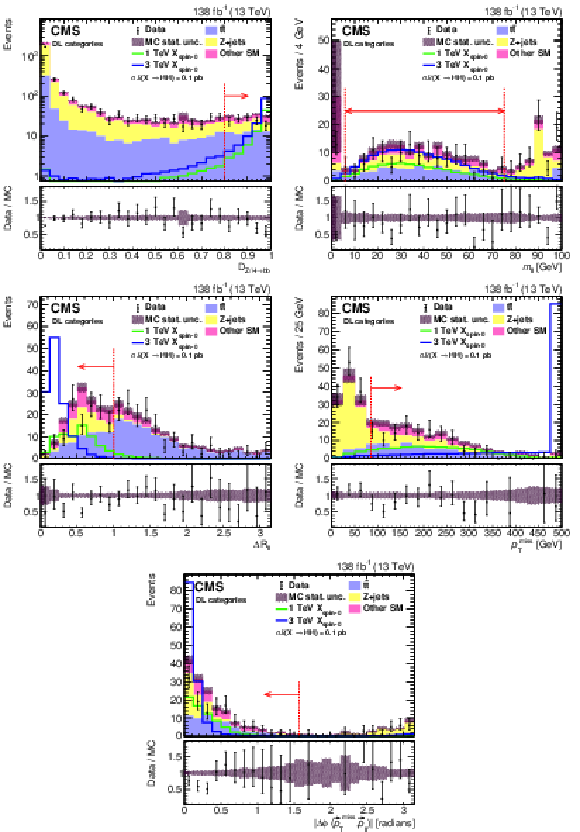
png pdf |
Figure 2:
Dilepton channel observables: distributions are shown for data (points), pre-fit simulated SM processes (filled histograms), and simulated signal (solid lines). The statistical uncertainty in the simulated sample is shown as the hatched band. Spin-0 signals for ${m_{\mathrm{X}}}$ of 1.0 and 3.0 TeV are displayed. The rightmost bin in the ${m_{\ell \ell}}$, ${{\Delta R}_{\ell \ell}}$, and ${{p_{\mathrm {T}}} ^\text {miss}}$ plots contains the overflow events. For both signal models, $\sigma \mathcal {B} (\mathrm{X} \to {\mathrm{H} \mathrm{H}})$ is set to 0.1 pb. The lower panels of each plot show the ratio of the data to the sum of all background processes. The red dashed line and arrow indicate the selected region of the variable of interest. |

png pdf |
Figure 2-a:
Dilepton channel observables: distributions are shown for data (points), pre-fit simulated SM processes (filled histograms), and simulated signal (solid lines). The statistical uncertainty in the simulated sample is shown as the hatched band. Spin-0 signals for ${m_{\mathrm{X}}}$ of 1.0 and 3.0 TeV are displayed. The rightmost bin in the ${m_{\ell \ell}}$, ${{\Delta R}_{\ell \ell}}$, and ${{p_{\mathrm {T}}} ^\text {miss}}$ plots contains the overflow events. For both signal models, $\sigma \mathcal {B} (\mathrm{X} \to {\mathrm{H} \mathrm{H}})$ is set to 0.1 pb. The lower panels of each plot show the ratio of the data to the sum of all background processes. The red dashed line and arrow indicate the selected region of the variable of interest. |
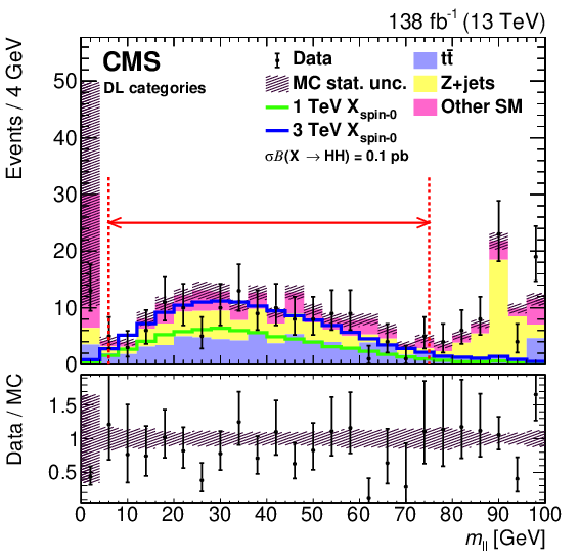
png pdf |
Figure 2-b:
Dilepton channel observables: distributions are shown for data (points), pre-fit simulated SM processes (filled histograms), and simulated signal (solid lines). The statistical uncertainty in the simulated sample is shown as the hatched band. Spin-0 signals for ${m_{\mathrm{X}}}$ of 1.0 and 3.0 TeV are displayed. The rightmost bin in the ${m_{\ell \ell}}$, ${{\Delta R}_{\ell \ell}}$, and ${{p_{\mathrm {T}}} ^\text {miss}}$ plots contains the overflow events. For both signal models, $\sigma \mathcal {B} (\mathrm{X} \to {\mathrm{H} \mathrm{H}})$ is set to 0.1 pb. The lower panels of each plot show the ratio of the data to the sum of all background processes. The red dashed line and arrow indicate the selected region of the variable of interest. |

png pdf |
Figure 2-c:
Dilepton channel observables: distributions are shown for data (points), pre-fit simulated SM processes (filled histograms), and simulated signal (solid lines). The statistical uncertainty in the simulated sample is shown as the hatched band. Spin-0 signals for ${m_{\mathrm{X}}}$ of 1.0 and 3.0 TeV are displayed. The rightmost bin in the ${m_{\ell \ell}}$, ${{\Delta R}_{\ell \ell}}$, and ${{p_{\mathrm {T}}} ^\text {miss}}$ plots contains the overflow events. For both signal models, $\sigma \mathcal {B} (\mathrm{X} \to {\mathrm{H} \mathrm{H}})$ is set to 0.1 pb. The lower panels of each plot show the ratio of the data to the sum of all background processes. The red dashed line and arrow indicate the selected region of the variable of interest. |
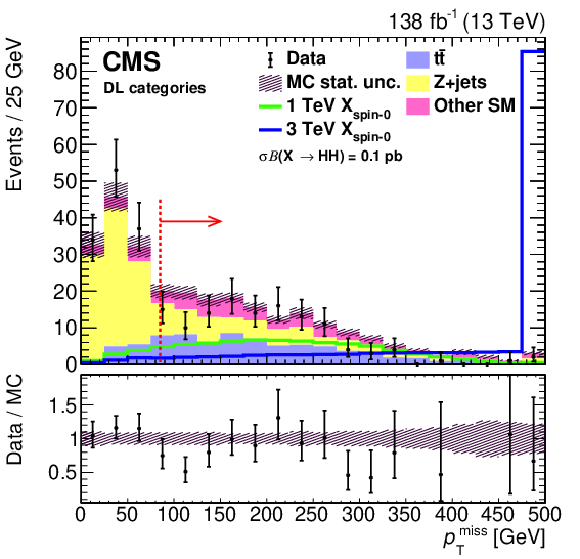
png pdf |
Figure 2-d:
Dilepton channel observables: distributions are shown for data (points), pre-fit simulated SM processes (filled histograms), and simulated signal (solid lines). The statistical uncertainty in the simulated sample is shown as the hatched band. Spin-0 signals for ${m_{\mathrm{X}}}$ of 1.0 and 3.0 TeV are displayed. The rightmost bin in the ${m_{\ell \ell}}$, ${{\Delta R}_{\ell \ell}}$, and ${{p_{\mathrm {T}}} ^\text {miss}}$ plots contains the overflow events. For both signal models, $\sigma \mathcal {B} (\mathrm{X} \to {\mathrm{H} \mathrm{H}})$ is set to 0.1 pb. The lower panels of each plot show the ratio of the data to the sum of all background processes. The red dashed line and arrow indicate the selected region of the variable of interest. |

png pdf |
Figure 2-e:
Dilepton channel observables: distributions are shown for data (points), pre-fit simulated SM processes (filled histograms), and simulated signal (solid lines). The statistical uncertainty in the simulated sample is shown as the hatched band. Spin-0 signals for ${m_{\mathrm{X}}}$ of 1.0 and 3.0 TeV are displayed. The rightmost bin in the ${m_{\ell \ell}}$, ${{\Delta R}_{\ell \ell}}$, and ${{p_{\mathrm {T}}} ^\text {miss}}$ plots contains the overflow events. For both signal models, $\sigma \mathcal {B} (\mathrm{X} \to {\mathrm{H} \mathrm{H}})$ is set to 0.1 pb. The lower panels of each plot show the ratio of the data to the sum of all background processes. The red dashed line and arrow indicate the selected region of the variable of interest. |

png pdf |
Figure 3:
The pre-fit ${m_{\mathrm{b} \mathrm{\bar{b}}}}$ distributions for the SL (upper row) and DL (lower row) channels. The data are shown as the points with error bars. In each plot, the pre-fit background (filled histograms) is shown broken down either according to the SM process (left) or according to the background classification of Section 6.1 (right). The total simulated background is the same in each case. The statistical uncertainty in the simulated sample is shown as the hatched band. Spin-0 signals for ${m_{\mathrm{X}}}$ of 1.0 and 3.0 TeV are also shown (solid lines). The product $\sigma \mathcal {B} (\mathrm{X} \to {\mathrm{H} \mathrm{H}})$ is set to 1.0 pb for the SL channel and 0.1 pb for the DL channel. The lower panels of each plot show the ratio of the data to the sum of all background processes. |
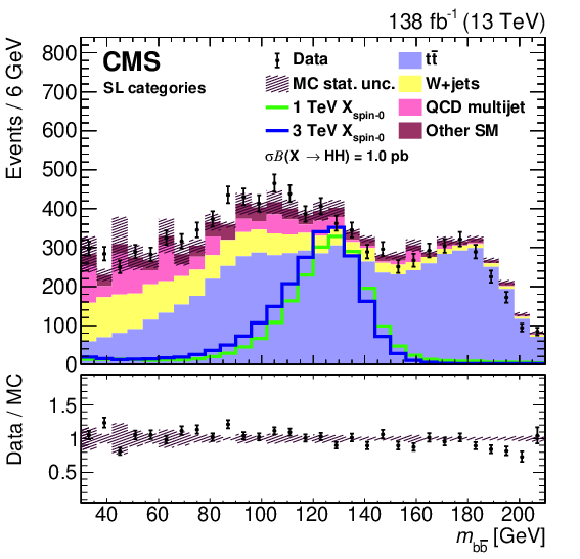
png pdf |
Figure 3-a:
The pre-fit ${m_{\mathrm{b} \mathrm{\bar{b}}}}$ distributions for the SL (upper row) and DL (lower row) channels. The data are shown as the points with error bars. In each plot, the pre-fit background (filled histograms) is shown broken down either according to the SM process (left) or according to the background classification of Section 6.1 (right). The total simulated background is the same in each case. The statistical uncertainty in the simulated sample is shown as the hatched band. Spin-0 signals for ${m_{\mathrm{X}}}$ of 1.0 and 3.0 TeV are also shown (solid lines). The product $\sigma \mathcal {B} (\mathrm{X} \to {\mathrm{H} \mathrm{H}})$ is set to 1.0 pb for the SL channel and 0.1 pb for the DL channel. The lower panels of each plot show the ratio of the data to the sum of all background processes. |

png pdf |
Figure 3-b:
The pre-fit ${m_{\mathrm{b} \mathrm{\bar{b}}}}$ distributions for the SL (upper row) and DL (lower row) channels. The data are shown as the points with error bars. In each plot, the pre-fit background (filled histograms) is shown broken down either according to the SM process (left) or according to the background classification of Section 6.1 (right). The total simulated background is the same in each case. The statistical uncertainty in the simulated sample is shown as the hatched band. Spin-0 signals for ${m_{\mathrm{X}}}$ of 1.0 and 3.0 TeV are also shown (solid lines). The product $\sigma \mathcal {B} (\mathrm{X} \to {\mathrm{H} \mathrm{H}})$ is set to 1.0 pb for the SL channel and 0.1 pb for the DL channel. The lower panels of each plot show the ratio of the data to the sum of all background processes. |

png pdf |
Figure 3-c:
The pre-fit ${m_{\mathrm{b} \mathrm{\bar{b}}}}$ distributions for the SL (upper row) and DL (lower row) channels. The data are shown as the points with error bars. In each plot, the pre-fit background (filled histograms) is shown broken down either according to the SM process (left) or according to the background classification of Section 6.1 (right). The total simulated background is the same in each case. The statistical uncertainty in the simulated sample is shown as the hatched band. Spin-0 signals for ${m_{\mathrm{X}}}$ of 1.0 and 3.0 TeV are also shown (solid lines). The product $\sigma \mathcal {B} (\mathrm{X} \to {\mathrm{H} \mathrm{H}})$ is set to 1.0 pb for the SL channel and 0.1 pb for the DL channel. The lower panels of each plot show the ratio of the data to the sum of all background processes. |

png pdf |
Figure 3-d:
The pre-fit ${m_{\mathrm{b} \mathrm{\bar{b}}}}$ distributions for the SL (upper row) and DL (lower row) channels. The data are shown as the points with error bars. In each plot, the pre-fit background (filled histograms) is shown broken down either according to the SM process (left) or according to the background classification of Section 6.1 (right). The total simulated background is the same in each case. The statistical uncertainty in the simulated sample is shown as the hatched band. Spin-0 signals for ${m_{\mathrm{X}}}$ of 1.0 and 3.0 TeV are also shown (solid lines). The product $\sigma \mathcal {B} (\mathrm{X} \to {\mathrm{H} \mathrm{H}})$ is set to 1.0 pb for the SL channel and 0.1 pb for the DL channel. The lower panels of each plot show the ratio of the data to the sum of all background processes. |
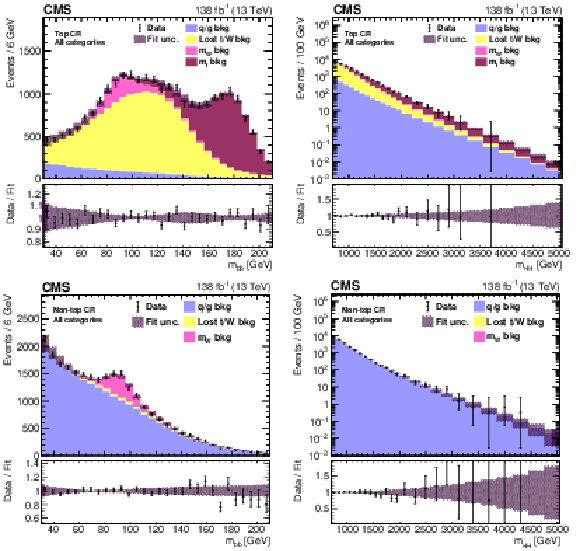
png pdf |
Figure 4:
The post-fit model compared to data in the top CR (upper plots) and non-top CR (lower plots), projected into ${m_{\mathrm{b} \mathrm{\bar{b}}}}$ (left) and ${m_{\mathrm{H} \mathrm{H}}}$ (right). Events from all categories are combined. The fit result is the filled histogram, with the different colors indicating different background components. The background shape uncertainty is shown as the hatched band. The lower panels of each plot show the ratio of the data to the fit result. |

png pdf |
Figure 4-a:
The post-fit model compared to data in the top CR (upper plots) and non-top CR (lower plots), projected into ${m_{\mathrm{b} \mathrm{\bar{b}}}}$ (left) and ${m_{\mathrm{H} \mathrm{H}}}$ (right). Events from all categories are combined. The fit result is the filled histogram, with the different colors indicating different background components. The background shape uncertainty is shown as the hatched band. The lower panels of each plot show the ratio of the data to the fit result. |

png pdf |
Figure 4-b:
The post-fit model compared to data in the top CR (upper plots) and non-top CR (lower plots), projected into ${m_{\mathrm{b} \mathrm{\bar{b}}}}$ (left) and ${m_{\mathrm{H} \mathrm{H}}}$ (right). Events from all categories are combined. The fit result is the filled histogram, with the different colors indicating different background components. The background shape uncertainty is shown as the hatched band. The lower panels of each plot show the ratio of the data to the fit result. |
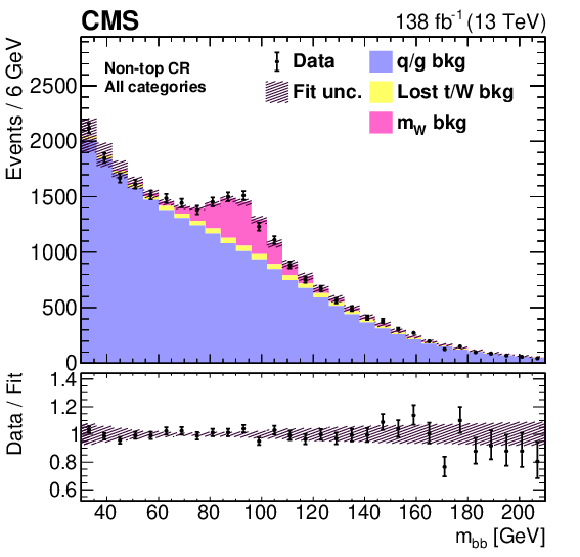
png pdf |
Figure 4-c:
The post-fit model compared to data in the top CR (upper plots) and non-top CR (lower plots), projected into ${m_{\mathrm{b} \mathrm{\bar{b}}}}$ (left) and ${m_{\mathrm{H} \mathrm{H}}}$ (right). Events from all categories are combined. The fit result is the filled histogram, with the different colors indicating different background components. The background shape uncertainty is shown as the hatched band. The lower panels of each plot show the ratio of the data to the fit result. |
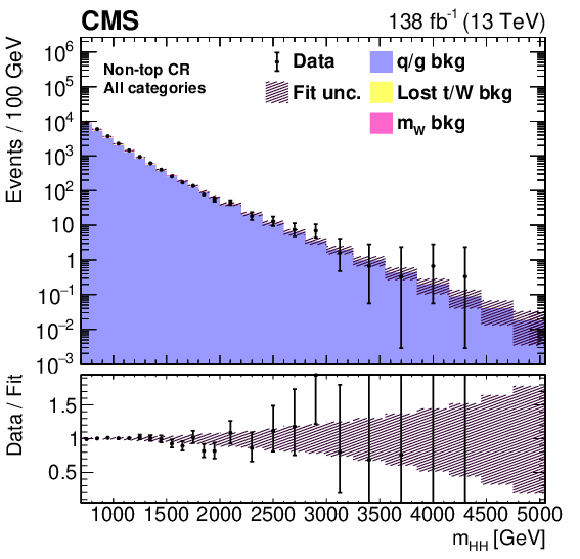
png pdf |
Figure 4-d:
The post-fit model compared to data in the top CR (upper plots) and non-top CR (lower plots), projected into ${m_{\mathrm{b} \mathrm{\bar{b}}}}$ (left) and ${m_{\mathrm{H} \mathrm{H}}}$ (right). Events from all categories are combined. The fit result is the filled histogram, with the different colors indicating different background components. The background shape uncertainty is shown as the hatched band. The lower panels of each plot show the ratio of the data to the fit result. |

png pdf |
Figure 5:
The background-only 2D fit result compared to data projected onto the ${m_{\mathrm{b} \mathrm{\bar{b}}}}$ axis for both the SL and DL channels. The label for each search category is in the upper left of each plot. The fit result is the filled histogram, with the different colors indicating different background components. The background shape uncertainty from the fit is shown as the hatched band. Example spin-0 signal distributions for $ {m_{\mathrm{X}}} = $ 1.0 and 3.0 TeV are shown as solid lines, with $\sigma \mathcal {B} (\mathrm{X} \to {\mathrm{H} \mathrm{H}})$ set to 0.2 and 0.1 pb for the SL and DL channels, respectively. The lower panels show the ratio of the data to the fit result. Only nonzero data entries are shown in the interest of clarity. |
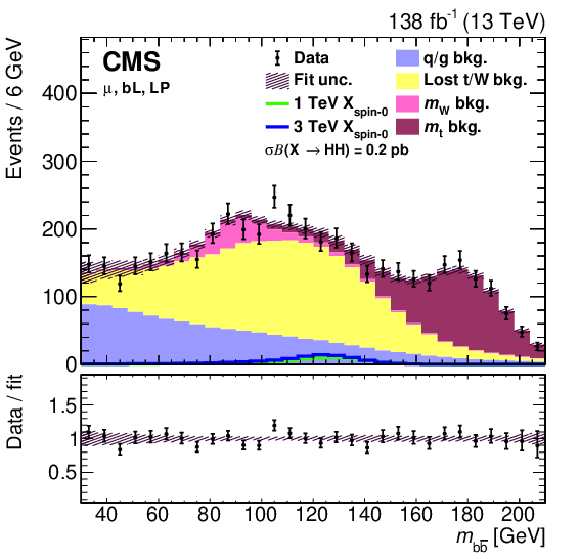
png pdf |
Figure 5-a:
The background-only 2D fit result compared to data projected onto the ${m_{\mathrm{b} \mathrm{\bar{b}}}}$ axis for both the SL and DL channels. The label for each search category is in the upper left of each plot. The fit result is the filled histogram, with the different colors indicating different background components. The background shape uncertainty from the fit is shown as the hatched band. Example spin-0 signal distributions for $ {m_{\mathrm{X}}} = $ 1.0 and 3.0 TeV are shown as solid lines, with $\sigma \mathcal {B} (\mathrm{X} \to {\mathrm{H} \mathrm{H}})$ set to 0.2 and 0.1 pb for the SL and DL channels, respectively. The lower panels show the ratio of the data to the fit result. Only nonzero data entries are shown in the interest of clarity. |

png pdf |
Figure 5-b:
The background-only 2D fit result compared to data projected onto the ${m_{\mathrm{b} \mathrm{\bar{b}}}}$ axis for both the SL and DL channels. The label for each search category is in the upper left of each plot. The fit result is the filled histogram, with the different colors indicating different background components. The background shape uncertainty from the fit is shown as the hatched band. Example spin-0 signal distributions for $ {m_{\mathrm{X}}} = $ 1.0 and 3.0 TeV are shown as solid lines, with $\sigma \mathcal {B} (\mathrm{X} \to {\mathrm{H} \mathrm{H}})$ set to 0.2 and 0.1 pb for the SL and DL channels, respectively. The lower panels show the ratio of the data to the fit result. Only nonzero data entries are shown in the interest of clarity. |

png pdf |
Figure 5-c:
The background-only 2D fit result compared to data projected onto the ${m_{\mathrm{b} \mathrm{\bar{b}}}}$ axis for both the SL and DL channels. The label for each search category is in the upper left of each plot. The fit result is the filled histogram, with the different colors indicating different background components. The background shape uncertainty from the fit is shown as the hatched band. Example spin-0 signal distributions for $ {m_{\mathrm{X}}} = $ 1.0 and 3.0 TeV are shown as solid lines, with $\sigma \mathcal {B} (\mathrm{X} \to {\mathrm{H} \mathrm{H}})$ set to 0.2 and 0.1 pb for the SL and DL channels, respectively. The lower panels show the ratio of the data to the fit result. Only nonzero data entries are shown in the interest of clarity. |

png pdf |
Figure 5-d:
The background-only 2D fit result compared to data projected onto the ${m_{\mathrm{b} \mathrm{\bar{b}}}}$ axis for both the SL and DL channels. The label for each search category is in the upper left of each plot. The fit result is the filled histogram, with the different colors indicating different background components. The background shape uncertainty from the fit is shown as the hatched band. Example spin-0 signal distributions for $ {m_{\mathrm{X}}} = $ 1.0 and 3.0 TeV are shown as solid lines, with $\sigma \mathcal {B} (\mathrm{X} \to {\mathrm{H} \mathrm{H}})$ set to 0.2 and 0.1 pb for the SL and DL channels, respectively. The lower panels show the ratio of the data to the fit result. Only nonzero data entries are shown in the interest of clarity. |
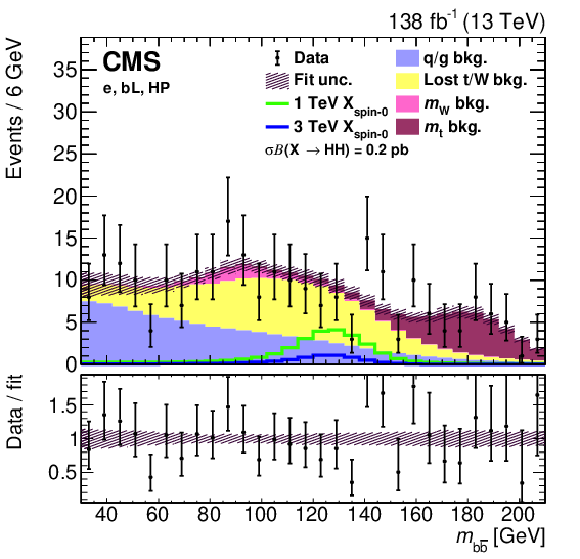
png pdf |
Figure 5-e:
The background-only 2D fit result compared to data projected onto the ${m_{\mathrm{b} \mathrm{\bar{b}}}}$ axis for both the SL and DL channels. The label for each search category is in the upper left of each plot. The fit result is the filled histogram, with the different colors indicating different background components. The background shape uncertainty from the fit is shown as the hatched band. Example spin-0 signal distributions for $ {m_{\mathrm{X}}} = $ 1.0 and 3.0 TeV are shown as solid lines, with $\sigma \mathcal {B} (\mathrm{X} \to {\mathrm{H} \mathrm{H}})$ set to 0.2 and 0.1 pb for the SL and DL channels, respectively. The lower panels show the ratio of the data to the fit result. Only nonzero data entries are shown in the interest of clarity. |

png pdf |
Figure 5-f:
The background-only 2D fit result compared to data projected onto the ${m_{\mathrm{b} \mathrm{\bar{b}}}}$ axis for both the SL and DL channels. The label for each search category is in the upper left of each plot. The fit result is the filled histogram, with the different colors indicating different background components. The background shape uncertainty from the fit is shown as the hatched band. Example spin-0 signal distributions for $ {m_{\mathrm{X}}} = $ 1.0 and 3.0 TeV are shown as solid lines, with $\sigma \mathcal {B} (\mathrm{X} \to {\mathrm{H} \mathrm{H}})$ set to 0.2 and 0.1 pb for the SL and DL channels, respectively. The lower panels show the ratio of the data to the fit result. Only nonzero data entries are shown in the interest of clarity. |

png pdf |
Figure 5-g:
The background-only 2D fit result compared to data projected onto the ${m_{\mathrm{b} \mathrm{\bar{b}}}}$ axis for both the SL and DL channels. The label for each search category is in the upper left of each plot. The fit result is the filled histogram, with the different colors indicating different background components. The background shape uncertainty from the fit is shown as the hatched band. Example spin-0 signal distributions for $ {m_{\mathrm{X}}} = $ 1.0 and 3.0 TeV are shown as solid lines, with $\sigma \mathcal {B} (\mathrm{X} \to {\mathrm{H} \mathrm{H}})$ set to 0.2 and 0.1 pb for the SL and DL channels, respectively. The lower panels show the ratio of the data to the fit result. Only nonzero data entries are shown in the interest of clarity. |

png pdf |
Figure 5-h:
The background-only 2D fit result compared to data projected onto the ${m_{\mathrm{b} \mathrm{\bar{b}}}}$ axis for both the SL and DL channels. The label for each search category is in the upper left of each plot. The fit result is the filled histogram, with the different colors indicating different background components. The background shape uncertainty from the fit is shown as the hatched band. Example spin-0 signal distributions for $ {m_{\mathrm{X}}} = $ 1.0 and 3.0 TeV are shown as solid lines, with $\sigma \mathcal {B} (\mathrm{X} \to {\mathrm{H} \mathrm{H}})$ set to 0.2 and 0.1 pb for the SL and DL channels, respectively. The lower panels show the ratio of the data to the fit result. Only nonzero data entries are shown in the interest of clarity. |

png pdf |
Figure 5-i:
The background-only 2D fit result compared to data projected onto the ${m_{\mathrm{b} \mathrm{\bar{b}}}}$ axis for both the SL and DL channels. The label for each search category is in the upper left of each plot. The fit result is the filled histogram, with the different colors indicating different background components. The background shape uncertainty from the fit is shown as the hatched band. Example spin-0 signal distributions for $ {m_{\mathrm{X}}} = $ 1.0 and 3.0 TeV are shown as solid lines, with $\sigma \mathcal {B} (\mathrm{X} \to {\mathrm{H} \mathrm{H}})$ set to 0.2 and 0.1 pb for the SL and DL channels, respectively. The lower panels show the ratio of the data to the fit result. Only nonzero data entries are shown in the interest of clarity. |
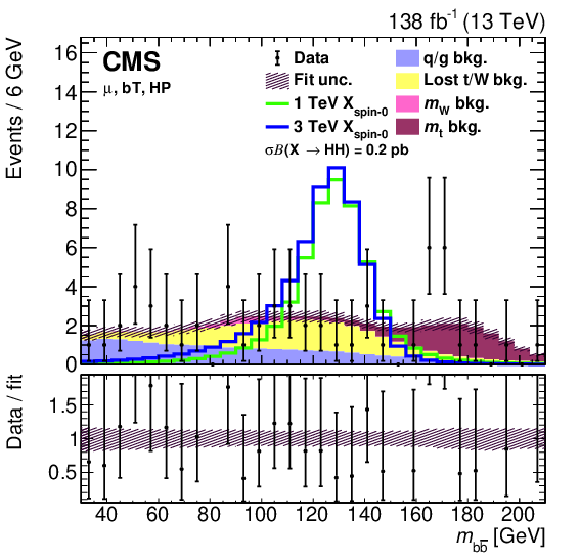
png pdf |
Figure 5-j:
The background-only 2D fit result compared to data projected onto the ${m_{\mathrm{b} \mathrm{\bar{b}}}}$ axis for both the SL and DL channels. The label for each search category is in the upper left of each plot. The fit result is the filled histogram, with the different colors indicating different background components. The background shape uncertainty from the fit is shown as the hatched band. Example spin-0 signal distributions for $ {m_{\mathrm{X}}} = $ 1.0 and 3.0 TeV are shown as solid lines, with $\sigma \mathcal {B} (\mathrm{X} \to {\mathrm{H} \mathrm{H}})$ set to 0.2 and 0.1 pb for the SL and DL channels, respectively. The lower panels show the ratio of the data to the fit result. Only nonzero data entries are shown in the interest of clarity. |

png pdf |
Figure 5-k:
The background-only 2D fit result compared to data projected onto the ${m_{\mathrm{b} \mathrm{\bar{b}}}}$ axis for both the SL and DL channels. The label for each search category is in the upper left of each plot. The fit result is the filled histogram, with the different colors indicating different background components. The background shape uncertainty from the fit is shown as the hatched band. Example spin-0 signal distributions for $ {m_{\mathrm{X}}} = $ 1.0 and 3.0 TeV are shown as solid lines, with $\sigma \mathcal {B} (\mathrm{X} \to {\mathrm{H} \mathrm{H}})$ set to 0.2 and 0.1 pb for the SL and DL channels, respectively. The lower panels show the ratio of the data to the fit result. Only nonzero data entries are shown in the interest of clarity. |
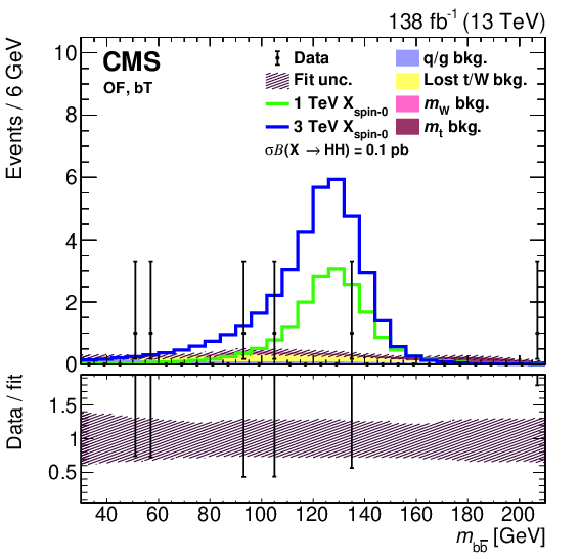
png pdf |
Figure 5-l:
The background-only 2D fit result compared to data projected onto the ${m_{\mathrm{b} \mathrm{\bar{b}}}}$ axis for both the SL and DL channels. The label for each search category is in the upper left of each plot. The fit result is the filled histogram, with the different colors indicating different background components. The background shape uncertainty from the fit is shown as the hatched band. Example spin-0 signal distributions for $ {m_{\mathrm{X}}} = $ 1.0 and 3.0 TeV are shown as solid lines, with $\sigma \mathcal {B} (\mathrm{X} \to {\mathrm{H} \mathrm{H}})$ set to 0.2 and 0.1 pb for the SL and DL channels, respectively. The lower panels show the ratio of the data to the fit result. Only nonzero data entries are shown in the interest of clarity. |

png pdf |
Figure 6:
The background-only 2D fit result compared to data projected onto the ${m_{\mathrm{H} \mathrm{H}}}$ axis for both the SL and DL channels. The label for each search category is in the upper left of each plot. The fit result is the filled histogram, with the different colors indicating different background components. The background shape uncertainty from the fit is shown as the hatched band. Example spin-0 signal distributions for $ {m_{\mathrm{X}}} = $ 1.0 and 3.0 TeV are shown as solid lines, with $\sigma \mathcal {B} (\mathrm{X} \to {\mathrm{H} \mathrm{H}})$ set to 0.2 and 0.1 pb for the SL and DL channels, respectively. The lower panels of each plot show the ratio of the data to the fit result. Only nonzero data entries are shown in the interest of clarity. |
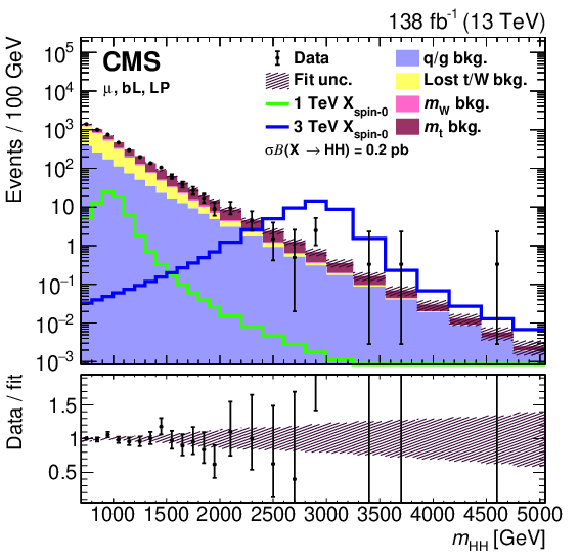
png pdf |
Figure 6-a:
The background-only 2D fit result compared to data projected onto the ${m_{\mathrm{H} \mathrm{H}}}$ axis for both the SL and DL channels. The label for each search category is in the upper left of each plot. The fit result is the filled histogram, with the different colors indicating different background components. The background shape uncertainty from the fit is shown as the hatched band. Example spin-0 signal distributions for $ {m_{\mathrm{X}}} = $ 1.0 and 3.0 TeV are shown as solid lines, with $\sigma \mathcal {B} (\mathrm{X} \to {\mathrm{H} \mathrm{H}})$ set to 0.2 and 0.1 pb for the SL and DL channels, respectively. The lower panels of each plot show the ratio of the data to the fit result. Only nonzero data entries are shown in the interest of clarity. |
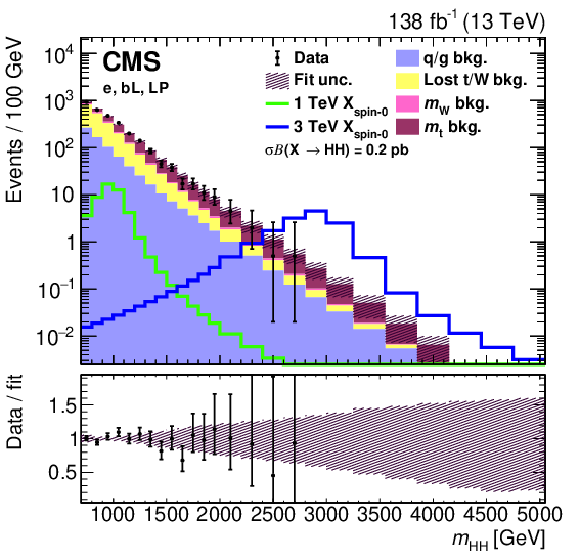
png pdf |
Figure 6-b:
The background-only 2D fit result compared to data projected onto the ${m_{\mathrm{H} \mathrm{H}}}$ axis for both the SL and DL channels. The label for each search category is in the upper left of each plot. The fit result is the filled histogram, with the different colors indicating different background components. The background shape uncertainty from the fit is shown as the hatched band. Example spin-0 signal distributions for $ {m_{\mathrm{X}}} = $ 1.0 and 3.0 TeV are shown as solid lines, with $\sigma \mathcal {B} (\mathrm{X} \to {\mathrm{H} \mathrm{H}})$ set to 0.2 and 0.1 pb for the SL and DL channels, respectively. The lower panels of each plot show the ratio of the data to the fit result. Only nonzero data entries are shown in the interest of clarity. |

png pdf |
Figure 6-c:
The background-only 2D fit result compared to data projected onto the ${m_{\mathrm{H} \mathrm{H}}}$ axis for both the SL and DL channels. The label for each search category is in the upper left of each plot. The fit result is the filled histogram, with the different colors indicating different background components. The background shape uncertainty from the fit is shown as the hatched band. Example spin-0 signal distributions for $ {m_{\mathrm{X}}} = $ 1.0 and 3.0 TeV are shown as solid lines, with $\sigma \mathcal {B} (\mathrm{X} \to {\mathrm{H} \mathrm{H}})$ set to 0.2 and 0.1 pb for the SL and DL channels, respectively. The lower panels of each plot show the ratio of the data to the fit result. Only nonzero data entries are shown in the interest of clarity. |
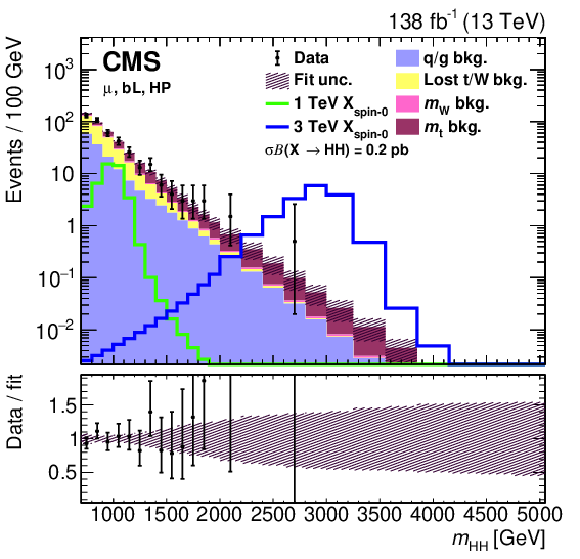
png pdf |
Figure 6-d:
The background-only 2D fit result compared to data projected onto the ${m_{\mathrm{H} \mathrm{H}}}$ axis for both the SL and DL channels. The label for each search category is in the upper left of each plot. The fit result is the filled histogram, with the different colors indicating different background components. The background shape uncertainty from the fit is shown as the hatched band. Example spin-0 signal distributions for $ {m_{\mathrm{X}}} = $ 1.0 and 3.0 TeV are shown as solid lines, with $\sigma \mathcal {B} (\mathrm{X} \to {\mathrm{H} \mathrm{H}})$ set to 0.2 and 0.1 pb for the SL and DL channels, respectively. The lower panels of each plot show the ratio of the data to the fit result. Only nonzero data entries are shown in the interest of clarity. |

png pdf |
Figure 6-e:
The background-only 2D fit result compared to data projected onto the ${m_{\mathrm{H} \mathrm{H}}}$ axis for both the SL and DL channels. The label for each search category is in the upper left of each plot. The fit result is the filled histogram, with the different colors indicating different background components. The background shape uncertainty from the fit is shown as the hatched band. Example spin-0 signal distributions for $ {m_{\mathrm{X}}} = $ 1.0 and 3.0 TeV are shown as solid lines, with $\sigma \mathcal {B} (\mathrm{X} \to {\mathrm{H} \mathrm{H}})$ set to 0.2 and 0.1 pb for the SL and DL channels, respectively. The lower panels of each plot show the ratio of the data to the fit result. Only nonzero data entries are shown in the interest of clarity. |

png pdf |
Figure 6-f:
The background-only 2D fit result compared to data projected onto the ${m_{\mathrm{H} \mathrm{H}}}$ axis for both the SL and DL channels. The label for each search category is in the upper left of each plot. The fit result is the filled histogram, with the different colors indicating different background components. The background shape uncertainty from the fit is shown as the hatched band. Example spin-0 signal distributions for $ {m_{\mathrm{X}}} = $ 1.0 and 3.0 TeV are shown as solid lines, with $\sigma \mathcal {B} (\mathrm{X} \to {\mathrm{H} \mathrm{H}})$ set to 0.2 and 0.1 pb for the SL and DL channels, respectively. The lower panels of each plot show the ratio of the data to the fit result. Only nonzero data entries are shown in the interest of clarity. |

png pdf |
Figure 6-g:
The background-only 2D fit result compared to data projected onto the ${m_{\mathrm{H} \mathrm{H}}}$ axis for both the SL and DL channels. The label for each search category is in the upper left of each plot. The fit result is the filled histogram, with the different colors indicating different background components. The background shape uncertainty from the fit is shown as the hatched band. Example spin-0 signal distributions for $ {m_{\mathrm{X}}} = $ 1.0 and 3.0 TeV are shown as solid lines, with $\sigma \mathcal {B} (\mathrm{X} \to {\mathrm{H} \mathrm{H}})$ set to 0.2 and 0.1 pb for the SL and DL channels, respectively. The lower panels of each plot show the ratio of the data to the fit result. Only nonzero data entries are shown in the interest of clarity. |

png pdf |
Figure 6-h:
The background-only 2D fit result compared to data projected onto the ${m_{\mathrm{H} \mathrm{H}}}$ axis for both the SL and DL channels. The label for each search category is in the upper left of each plot. The fit result is the filled histogram, with the different colors indicating different background components. The background shape uncertainty from the fit is shown as the hatched band. Example spin-0 signal distributions for $ {m_{\mathrm{X}}} = $ 1.0 and 3.0 TeV are shown as solid lines, with $\sigma \mathcal {B} (\mathrm{X} \to {\mathrm{H} \mathrm{H}})$ set to 0.2 and 0.1 pb for the SL and DL channels, respectively. The lower panels of each plot show the ratio of the data to the fit result. Only nonzero data entries are shown in the interest of clarity. |

png pdf |
Figure 6-i:
The background-only 2D fit result compared to data projected onto the ${m_{\mathrm{H} \mathrm{H}}}$ axis for both the SL and DL channels. The label for each search category is in the upper left of each plot. The fit result is the filled histogram, with the different colors indicating different background components. The background shape uncertainty from the fit is shown as the hatched band. Example spin-0 signal distributions for $ {m_{\mathrm{X}}} = $ 1.0 and 3.0 TeV are shown as solid lines, with $\sigma \mathcal {B} (\mathrm{X} \to {\mathrm{H} \mathrm{H}})$ set to 0.2 and 0.1 pb for the SL and DL channels, respectively. The lower panels of each plot show the ratio of the data to the fit result. Only nonzero data entries are shown in the interest of clarity. |

png pdf |
Figure 6-j:
The background-only 2D fit result compared to data projected onto the ${m_{\mathrm{H} \mathrm{H}}}$ axis for both the SL and DL channels. The label for each search category is in the upper left of each plot. The fit result is the filled histogram, with the different colors indicating different background components. The background shape uncertainty from the fit is shown as the hatched band. Example spin-0 signal distributions for $ {m_{\mathrm{X}}} = $ 1.0 and 3.0 TeV are shown as solid lines, with $\sigma \mathcal {B} (\mathrm{X} \to {\mathrm{H} \mathrm{H}})$ set to 0.2 and 0.1 pb for the SL and DL channels, respectively. The lower panels of each plot show the ratio of the data to the fit result. Only nonzero data entries are shown in the interest of clarity. |
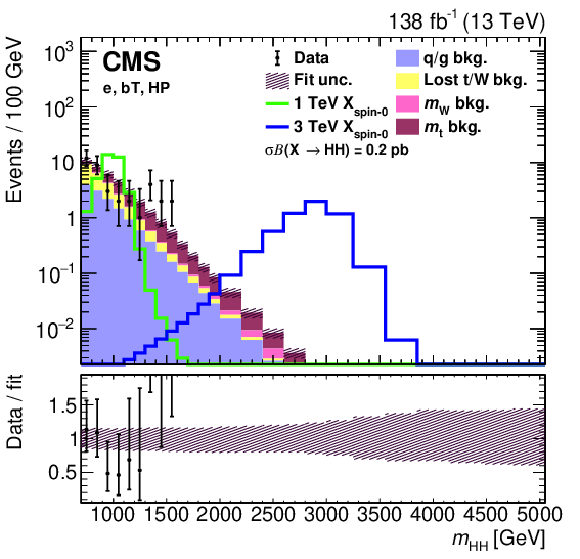
png pdf |
Figure 6-k:
The background-only 2D fit result compared to data projected onto the ${m_{\mathrm{H} \mathrm{H}}}$ axis for both the SL and DL channels. The label for each search category is in the upper left of each plot. The fit result is the filled histogram, with the different colors indicating different background components. The background shape uncertainty from the fit is shown as the hatched band. Example spin-0 signal distributions for $ {m_{\mathrm{X}}} = $ 1.0 and 3.0 TeV are shown as solid lines, with $\sigma \mathcal {B} (\mathrm{X} \to {\mathrm{H} \mathrm{H}})$ set to 0.2 and 0.1 pb for the SL and DL channels, respectively. The lower panels of each plot show the ratio of the data to the fit result. Only nonzero data entries are shown in the interest of clarity. |
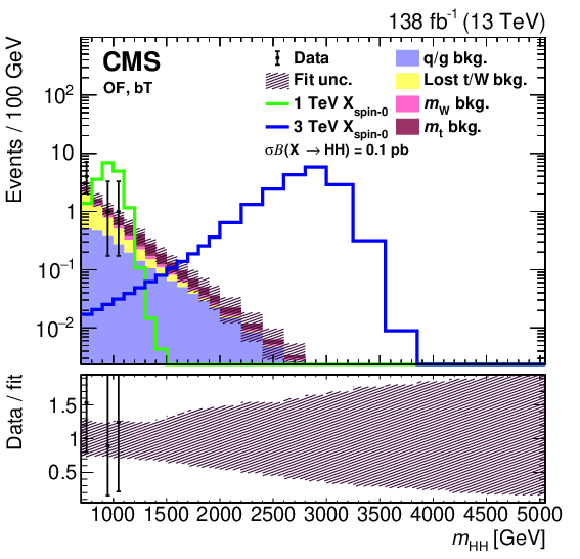
png pdf |
Figure 6-l:
The background-only 2D fit result compared to data projected onto the ${m_{\mathrm{H} \mathrm{H}}}$ axis for both the SL and DL channels. The label for each search category is in the upper left of each plot. The fit result is the filled histogram, with the different colors indicating different background components. The background shape uncertainty from the fit is shown as the hatched band. Example spin-0 signal distributions for $ {m_{\mathrm{X}}} = $ 1.0 and 3.0 TeV are shown as solid lines, with $\sigma \mathcal {B} (\mathrm{X} \to {\mathrm{H} \mathrm{H}})$ set to 0.2 and 0.1 pb for the SL and DL channels, respectively. The lower panels of each plot show the ratio of the data to the fit result. Only nonzero data entries are shown in the interest of clarity. |

png pdf |
Figure 7:
Observed and expected 95% CL upper limits on the product of the cross section and branching fraction to HH for a generic spin-0 (left) and spin-2 (right) boson X, as functions of mass. Example radion and bulk graviton predictions are also shown. The HH branching fraction is assumed to be 25% for radions and 10% for bulk gravitons. |
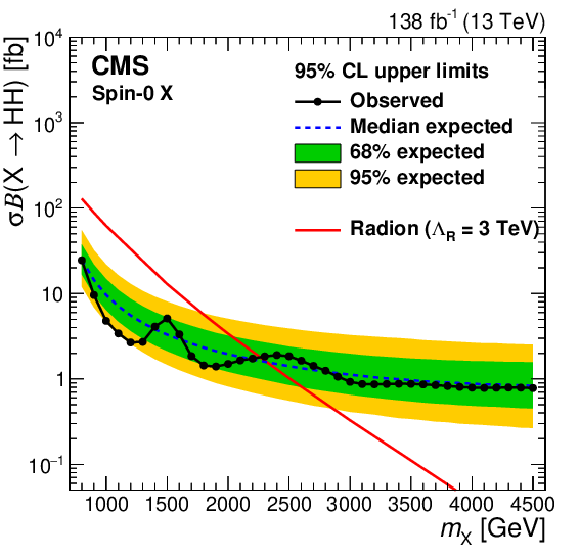
png pdf |
Figure 7-a:
Observed and expected 95% CL upper limits on the product of the cross section and branching fraction to HH for a generic spin-0 (left) and spin-2 (right) boson X, as functions of mass. Example radion and bulk graviton predictions are also shown. The HH branching fraction is assumed to be 25% for radions and 10% for bulk gravitons. |

png pdf |
Figure 7-b:
Observed and expected 95% CL upper limits on the product of the cross section and branching fraction to HH for a generic spin-0 (left) and spin-2 (right) boson X, as functions of mass. Example radion and bulk graviton predictions are also shown. The HH branching fraction is assumed to be 25% for radions and 10% for bulk gravitons. |
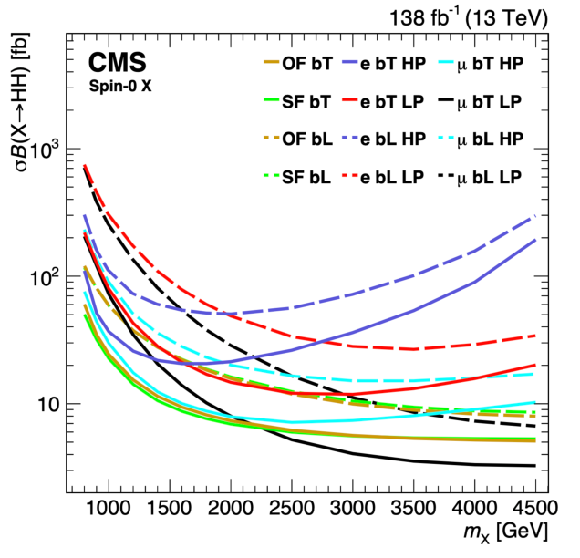
png pdf |
Figure 8:
Median expected upper limits at 95% confidence level for each of the 12 search categories individually. |
| Tables | |

png pdf |
Table 1:
The SL channel event categorization and corresponding category labels. All combinations of the two lepton flavors, two $\mathrm{b} \mathrm{\bar{b}}$ jet tagging, and two ${\mathrm{H} \to \mathrm{W} \mathrm{W} ^*}$ decay purity selections are used to form eight independent event categories. The lower ${\tau _{2}/\tau _{1}}$ working point is 0.55 (0.45) in 2016 (2017-2018). |

png pdf |
Table 2:
The DL channel event categorization and corresponding category labels. All combinations of the two lepton flavors and two $\mathrm{b} \mathrm{\bar{b}}$ jet tagging selections are used to form four independent event categories. |
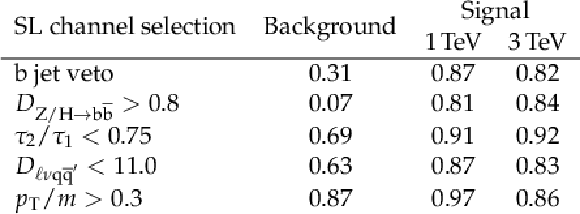
png pdf |
Table 3:
Efficiencies of each selection criterion in the SL channel with the rest of the full selection applied. The efficiencies for the total expected SM background and signals at 1.0 and 3.0 TeV are shown. |

png pdf |
Table 4:
Efficiencies of each selection criterion in the DL channel with the rest of the full selection applied. The efficiencies for the total expected SM background and signals at 1.0 and 3.0 TeV are shown. |

png pdf |
Table 5:
The four background components with their kinematical properties and defining number of generator-level quarks within $ {\Delta R} < $ 0.8 of the $\mathrm{b} \mathrm{\bar{b}}$ jet axis. |

png pdf |
Table 6:
Background systematic uncertainties included in the maximum likelihood fit. The uncertainty types with "normalization" correspond to uncertainties in the background yield, while all others are uncertainties in the background shape. The $N_{\text {p}}$ column indicates the number of nuisance parameters used to model the uncertainty. In the last two columns, $\sigma _{\text {I}}$ refers to the initial estimate of the uncertainty, and $\sigma _{\text {C}}$ refers to the constrained uncertainty obtained post-fit. For the q/g, ${\mathrm{t} \mathrm{\bar{t}}}$, and lost-t/W shape uncertainties, "scale'' uncertainties are those implemented with alternative templates with multiplicative parameters proportional to mass $m$, and "inverse scale'' uncertainties are those implemented with parameters proportional to $1/m$. |

png pdf |
Table 7:
Signal systematic uncertainties included in the maximum likelihood fit. The $N_{\text {p}}$ column indicates the number of nuisance parameters used to model the uncertainty. In the "Uncertainty values'' column, some uncertainties are noted as affecting both the yield ($Y$) and ${m_{\mathrm{H} \mathrm{H}}}$ shape ($S$ for scale, $R$ for resolution) of the signal. All other uncertainties, except the SD jet mass uncertainties, are uncertainties in the signal yield alone. |
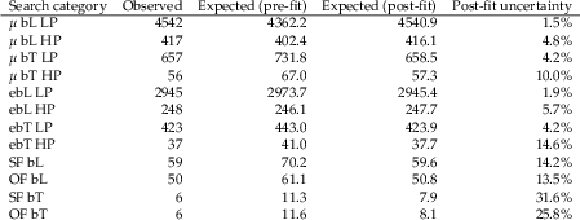
png pdf |
Table 8:
Event yields broken down by search category. For each category, shown are the event yields observed in data, expected before and after a fit of the background-only model, and the corresponding relative uncertainty. |
| Summary |
| A search has been performed for new bosons (narrow resonances) decaying to a pair of Higgs bosons (HH) where one decays into a bottom quark pair ($\mathrm{b\bar{b}}$) and the other via one of three different modes into final states with leptons. The large Lorentz boost of the Higgs bosons produces a distinct experimental signature with one jet that has substructure consistent with the decay H $ \to $ $\mathrm{b\bar{b}}$. For the Higgs boson that does not decay to $\mathrm{b\bar{b}}$, the single-lepton decay H $ \to $ WW* $\to {\ell} \nu $qq' and the dilepton decays H $ \to $ WW* $\to{\ell} \nu{\ell} \nu $ and H $ \to $ ${\tau\tau \to{\ell} \nu\nu{\ell} \nu\nu} $ are considered. In the single-lepton channel, the experimental signature is characterized by a second large jet with a nearby lepton, which is consistent with the decay of H $ \to $ WW*. In the dilepton channel, the experimental signature contains two leptons and significant missing transverse momentum. This search uses a sample of proton-proton collisions at $\sqrt{s} = $ 13 TeV, corresponding to an integrated luminosity of 138 fb$^{-1}$, collected by the CMS detector at the LHC. The primary standard model backgrounds--production of top quark pairs and of vector bosons in association with jets--are suppressed by reconstructing the HH decay chain and applying selections to discriminate signal from background. The signal and background yields are estimated by a two-dimensional template fit in the plane of the ${\mathrm{b\bar{b}} \text{jet}}$ mass and the HH resonance mass. The templates are validated in a variety of data control regions and are shown to model the data well. The data are consistent with the expected standard model background. Upper limits are set on the product of the cross section and branching fraction for new bosons decaying toHH. The observed limit at 95% confidence level for a spin-0 (spin-2) boson ranges from 24.5 (16.7) fb at 0.8 TeV to 0.78 (0.67) fb at 4.5 TeV. The results of this search provide the most stringent exclusion limits to date for X $ \to $ HH signatures with leptons in the final state and are among the most stringent of all X $ \to $ HH searches, at certain mass points the most sensitive. |
| References | ||||
| 1 | ATLAS Collaboration | Observation of a new particle in the search for the standard model Higgs boson with the ATLAS detector at the LHC | PLB 716 (2012) 01 | 1207.7214 |
| 2 | CMS Collaboration | Observation of a new boson at a mass of 125 GeV with the CMS experiment at the LHC | PLB 716 (2012) 30 | CMS-HIG-12-028 1207.7235 |
| 3 | CMS Collaboration | Observation of a new boson with mass near 125 GeV in pp collisions at $ \sqrt{s} = $ 7 and 8~TeV | JHEP 06 (2013) 081 | CMS-HIG-12-036 1303.4571 |
| 4 | F. Englert and R. Brout | Broken symmetry and the mass of gauge vector mesons | PRL 13 (1964) 321 | |
| 5 | P. W. Higgs | Broken symmetries and the masses of gauge bosons | PRL 13 (1964) 508 | |
| 6 | G. C. Branco et al. | Theory and phenomenology of two-Higgs-doublet models | PR 516 (2012) 1 | 1106.0034 |
| 7 | P. Ramond | Dual theory for free fermions | PRD 3 (1971) 2415 | |
| 8 | Y. A. Golfand and E. P. Likhtman | Extension of the algebra of Poincar$ \'e $ group generators and violation of P invariance | JEPTL 13 (1971)323 | |
| 9 | A. Neveu and J. H. Schwarz | Factorizable dual model of pions | NPB 31 (1971) 86 | |
| 10 | D. V. Volkov and V. P. Akulov | Possible universal neutrino interaction | JEPTL 16 (1972)438 | |
| 11 | J. Wess and B. Zumino | A Lagrangian model invariant under supergauge transformations | PLB 49 (1974) 52 | |
| 12 | J. Wess and B. Zumino | Supergauge transformations in four dimensions | NPB 70 (1974) 39 | |
| 13 | P. Fayet | Supergauge invariant extension of the Higgs mechanism and a model for the electron and its neutrino | NPB 90 (1975) 104 | |
| 14 | H. P. Nilles | Supersymmetry, supergravity and particle physics | Phys. Rep. 110 (1984) 1 | |
| 15 | L. Randall and R. Sundrum | A large mass hierarchy from a small extra dimension | PRL 83 (1999) 3370 | hep-ph/9905221 |
| 16 | W. D. Goldberger and M. B. Wise | Modulus stabilization with bulk fields | PRL 83 (1999) 4922 | hep-ph/9907447 |
| 17 | O. DeWolfe, D. Z. Freedman, S. S. Gubser, and A. Karch | Modeling the fifth dimension with scalars and gravity | PRD 62 (2000) 046008 | hep-th/9909134 |
| 18 | C. Csaki, M. Graesser, L. Randall, and J. Terning | Cosmology of brane models with radion stabilization | PRD 62 (2000) 045015 | hep-ph/9911406 |
| 19 | C. Csaki, M. L. Graesser, and G. D. Kribs | Radion dynamics and electroweak physics | PRD 63 (2001) 065002 | hep-th/0008151 |
| 20 | H. Davoudiasl, J. L. Hewett, and T. G. Rizzo | Phenomenology of the Randall-Sundrum gauge hierarchy model | PRL 84 (2000) 2080 | hep-ph/9909255 |
| 21 | K. Agashe, H. Davoudiasl, G. Perez, and A. Soni | Warped gravitons at the LHC and beyond | PRD 76 (2007) 036006 | hep-ph/0701186 |
| 22 | L. Fitzpatrick, J. Kaplan, L. Randall, and L.-T. Wang | Searching for the Kaluza-Klein graviton in bulk RS models | JHEP 09 (2007) 013 | hep-ph/0701150 |
| 23 | ATLAS Collaboration | Search for resonant $ WZ $ production in the fully leptonic final state in proton-proton collisions at $ \sqrt{s} = $ 13 TeV with the ATLAS detector | PLB 787 (2018) 68 | 1806.01532 |
| 24 | ATLAS Collaboration | Search for heavy resonances decaying into $ WW $ in the $ e\nu\mu\nu $ final state in $ pp $ collisions at $ \sqrt{s}= $ 13 TeV with the ATLAS detector | EPJC 78 (2018) 24 | 1710.01123 |
| 25 | ATLAS Collaboration | Search for heavy ZZ resonances in the $ \ell ^+\ell ^-\ell ^+\ell ^- $ and $ \ell ^+\ell ^-\nu \bar{\nu} $ final states using proton-proton collisions at $ \sqrt{s}= $ 13 TeV with the ATLAS detector | EPJC 78 (2018) 293 | 1712.06386 |
| 26 | ATLAS Collaboration | Search for heavy resonances decaying into a $ W $ or $ Z $ boson and a Higgs boson in final states with leptons and $ b $-jets in 36 fb$ ^{-1} $ of $ \sqrt s = 13 TeV pp $ collisions with the ATLAS detector | JHEP 03 (2018) 174 | 1712.06518 |
| 27 | ATLAS Collaboration | Search for Higgs boson pair production in the $ b\bar{b} WW^{*} $ decay mode at $ \sqrt{s}= $ 13 ~TeV with the ATLAS detector | JHEP 04 (2019) 092 | 1811.04671 |
| 28 | ATLAS Collaboration | Search for diboson resonances in hadronic final states in 139 fb$ ^{-1} $ of $ pp $ collisions at $ \sqrt{s} = $ 13 TeV with the ATLAS detector | JHEP 09 (2019) 091 | 1906.08589 |
| 29 | ATLAS Collaboration | Search for the $ HH \rightarrow b \bar{b} b \bar{b} $ process via vector-boson fusion production using proton-proton collisions at $ \sqrt{s} = $ 13 TeV with the ATLAS detector | JHEP 07 (2020) 108 | 2001.05178 |
| 30 | ATLAS Collaboration | Search for heavy diboson resonances in semileptonic final states in pp collisions at $ \sqrt{s}= $ 13 TeV with the ATLAS detector | EPJC 80 (2020) 1165 | 2004.14636 |
| 31 | ATLAS Collaboration | Search for resonances decaying into a weak vector boson and a Higgs boson in the fully hadronic final state produced in proton$ - $proton collisions at $ \sqrt{s} = $ 13 TeV with the ATLAS detector | PRD 102 (2020) 112008 | 2007.05293 |
| 32 | ATLAS Collaboration | Reconstruction and identification of boosted di-$ \tau $ systems in a search for Higgs boson pairs using 13 TeV proton-proton collision data in ATLAS | JHEP 11 (2020) 163 | 2007.14811 |
| 33 | ATLAS Collaboration | Search for resonant pair production of Higgs bosons in the $ b\bar{b}b\bar{b} $ final state using $ pp $ collisions at $ \sqrt{s} = $ 13 TeV with the ATLAS detector | 2022. Submitted to PRD | 2202.07288 |
| 34 | ATLAS Collaboration | Combination of searches for heavy resonances decaying into bosonic and leptonic final states using 36 fb$ ^{-1} $ of proton-proton collision data at $ \sqrt{s} = $ 13 TeV with the ATLAS detector | PRD 98 (2018) 052008 | 1808.02380 |
| 35 | CMS Collaboration | Combination of searches for heavy resonances decaying to WW, WZ, ZZ, WH, and ZH boson pairs in proton-proton collisions at $ \sqrt{s}= $ 8 and 13 TeV | PLB 774 (2017) 533 | CMS-B2G-16-007 1705.09171 |
| 36 | CMS Collaboration | Search for heavy resonances decaying into two Higgs bosons or into a Higgs boson and a W or Z boson in proton-proton collisions at 13 TeV | JHEP 01 (2019) 051 | CMS-B2G-17-006 1808.01365 |
| 37 | CMS Collaboration | Search for a heavy resonance decaying into a Z boson and a Z or W boson in 2$ \ell $2q final states at $ \sqrt{s}= $ 13 TeV | JHEP 09 (2018) 101 | CMS-B2G-17-013 1803.10093 |
| 38 | CMS Collaboration | Search for production of Higgs boson pairs in the four b quark final state using large-area jets in proton-proton collisions at $ \sqrt{s}= $ 13 TeV | JHEP 01 (2019) 040 | CMS-B2G-17-019 1808.01473 |
| 39 | CMS Collaboration | Search for massive resonances decaying into $ WW $, $ WZ $, $ ZZ $, $ qW $, and $ qZ $ with dijet final states at $ \sqrt{s}= $ 13 TeV | PRD 97 (2018) 072006 | CMS-B2G-17-001 1708.05379 |
| 40 | CMS Collaboration | Search for heavy resonances that decay into a vector boson and a Higgs boson in hadronic final states at $ \sqrt{s} = $ 13 TeV | EPJC 77 (2017) 636 | CMS-B2G-17-002 1707.01303 |
| 41 | CMS Collaboration | Search for heavy resonances decaying into a vector boson and a Higgs boson in final states with charged leptons, neutrinos and b quarks at $ \sqrt{s}= $ 13 TeV | JHEP 11 (2018) 172 | CMS-B2G-17-004 1807.02826 |
| 42 | CMS Collaboration | Search for a massive resonance decaying to a pair of Higgs bosons in the four b quark final state in proton-proton collisions at $ \sqrt{s}= $ 13 TeV | PLB 781 (2018) 244 | 1710.04960 |
| 43 | CMS Collaboration | Search for massive resonances decaying into WW, WZ or ZZ bosons in proton-proton collisions at $ \sqrt{s} = 13{TeV} $ | JHEP 03 (2017) 162 | CMS-B2G-16-004 1612.09159 |
| 44 | CMS Collaboration | Search for ZZ resonances in the 2$ \ell 2 \nu $ final state in proton-proton collisions at 13 TeV | JHEP 03 (2018) 003 | CMS-B2G-16-023 1711.04370 |
| 45 | CMS Collaboration | Search for new resonances decaying via WZ to leptons in proton-proton collisions at $ \sqrt{s} = $ 13 TeV | PLB 740 (2015) 83 | CMS-EXO-12-025 1407.3476 |
| 46 | CMS Collaboration | Search for narrow high-mass resonances in proton-proton collisions at $ \sqrt{s} = $ 8 TeV decaying to a Z and a Higgs boson | PLB 748 (2015) 255 | CMS-EXO-13-007 1502.04994 |
| 47 | CMS Collaboration | Combination of CMS searches for heavy resonances decaying to pairs of bosons or leptons | PLB 798 (2019) 134952 | CMS-B2G-18-006 1906.00057 |
| 48 | CMS Collaboration | Search for a heavy vector resonance decaying to a $ {\mathrm{Z}}_{\mathrm{}}^{\mathrm{}} $ ~boson and a Higgs boson in proton-proton collisions at $ \sqrt{s} = 13 \text {Te}\text {V} $ | EPJC 81 (2021) 688 | CMS-B2G-19-006 2102.08198 |
| 49 | CMS Collaboration | Search for heavy resonances decaying to $ WW $, $ WZ $, or $ WH $ boson pairs in a final state consisting of a lepton and a large-radius jet in proton-proton collisions at $ \sqrt{s}=13\text{}\text{}\mathrm{TeV} $ | PRD 105 (2022) 032008 | CMS-B2G-19-002 2109.06055 |
| 50 | CMS Collaboration | Search for heavy resonances decaying to Z($ \nu\bar{\nu} $)V(q$ \bar{\mathrm{q}} $') in proton-proton collisions at $ \sqrt{s} = $ 13 TeV | 2021. Submitted to PRD | CMS-B2G-20-008 2109.08268 |
| 51 | CMS Collaboration | Search for heavy resonances decaying to ZZ or ZW and axion-like particles mediating nonresonant ZZ or ZH production at $ \sqrt{s} = $ 13 TeV | 2021. Submitted to JHEP | CMS-B2G-20-013 2111.13669 |
| 52 | CMS Collaboration | Search for resonances decaying to a pair of Higgs bosons in the $ \mathrm{b\bar{b}} \mathrm{q\bar{q}}' \ell \nu $ final state in proton-proton collisions at $ \sqrt{s}=$ 13 TeV | JHEP 10 (2019) 125 | 1904.04193 |
| 53 | CMS Collaboration | HEPData record for this analysis | link | |
| 54 | CMS Collaboration | The CMS experiment at the CERN LHC | JINST 3 (2008) S08004 | CMS-00-001 |
| 55 | CMS Collaboration | Performance of the CMS Level-1 trigger in proton-proton collisions at $ \sqrt{s} = $ 13 TeV | JINST 15 (2020) P10017 | CMS-TRG-17-001 2006.10165 |
| 56 | CMS Collaboration | The CMS trigger system | JINST 12 (2017) P01020 | CMS-TRG-12-001 1609.02366 |
| 57 | CMS Collaboration | Particle-flow reconstruction and global event description with the CMS detector | JINST 12 (2017) P10003 | CMS-PRF-14-001 1706.04965 |
| 58 | CMS Collaboration | Performance of missing transverse momentum reconstruction in proton-proton collisions at $ \sqrt{s} = $ 13 TeV using the CMS detector | JINST 14 (2019) P07004 | CMS-JME-17-001 1903.06078 |
| 59 | M. Cacciari, G. P. Salam, and G. Soyez | The anti-$ {k_{\mathrm{T}}} $ jet clustering algorithm | JHEP 04 (2008) 063 | 0802.1189 |
| 60 | M. Cacciari, G. P. Salam, and G. Soyez | FastJet user manual | EPJC 72 (2012) 1896 | 1111.6097 |
| 61 | CMS Collaboration | Pileup mitigation at CMS in 13~TeV data | JINST 15 (2020) P09018 | CMS-JME-18-001 2003.00503 |
| 62 | D. Bertolini, P. Harris, M. Low, and N. Tran | Pileup per particle identification | JHEP 10 (2014) 059 | 1407.6013 |
| 63 | CMS Collaboration | Jet energy scale and resolution in the CMS experiment in pp collisions at 8 TeV | JINST 12 (2017) P02014 | CMS-JME-13-004 1607.03663 |
| 64 | J. Alwall et al. | The automated computation of tree-level and next-to-leading order differential cross sections, and their matching to parton shower simulations | JHEP 07 (2014) 079 | 1405.0301 |
| 65 | J. Alwall et al. | Comparative study of various algorithms for the merging of parton showers and matrix elements in hadronic collisions | EPJC 53 (2008) 473 | 0706.2569 |
| 66 | Y. Li and F. Petriello | Combining QCD and electroweak corrections to dilepton production in the framework of the FEWZ simulation code | PRD 86 (2012) 094034 | 1208.5967 |
| 67 | R. Frederix and S. Frixione | Merging meets matching in MC@NLO | JHEP 12 (2012) 61 | 1209.6215 |
| 68 | P. Nason | A new method for combining NLO QCD with shower Monte Carlo algorithms | JHEP 11 (2004) 040 | hep-ph/0409146 |
| 69 | S. Frixione, P. Nason, and C. Oleari | Matching NLO QCD computations with parton shower simulations: the POWHEG method | JHEP 11 (2007) 070 | 0709.2092 |
| 70 | S. Alioli, P. Nason, C. Oleari, and E. Re | A general framework for implementing NLO calculations in shower Monte Carlo programs: the POWHEG BOX | JHEP 06 (2010) 043 | 1002.2581 |
| 71 | E. Re | Single-top $ Wt $-channel production matched with parton showers using the POWHEG method | EPJC 71 (2011) 1547 | 1009.2450 |
| 72 | T. Melia, P. Nason, R. Rontsch, and G. Zanderighi | $ \mathrm{W}^+\mathrm{W}^- $, $ \mathrm{W}\mathrm{Z} $ and $ \mathrm{Z}\mathrm{Z} $ production in the POWHEG BOX | JHEP 11 (2011) 078 | 1107.5051 |
| 73 | P. Nason and G. Zanderighi | $ W^+ W^- $ , $ W Z $ and $ Z Z $ production in the POWHEG-BOX-V2 | EPJC 74 (2014) 2702 | 1311.1365 |
| 74 | R. Frederix, E. Re, and P. Torrielli | Single-top $ t $-channel hadroproduction in the four-flavour scheme with POWHEG and aMC@NLO | JHEP 09 (2012) 130 | 1207.5391 |
| 75 | H. B. Hartanto, B. Jager, L. Reina, and D. Wackeroth | Higgs boson production in association with top quarks in the POWHEG BOX | PRD 91 (2015) 094003 | 1501.04498 |
| 76 | M. Czakon and A. Mitov | Top++: A program for the calculation of the top-pair cross-section at hadron colliders | CPC 185 (2014) 2930 | 1112.5675 |
| 77 | T. Sjostrand et al. | An introduction to PYTHIA 8.2 | CPC 191 (2015) 159 | 1410.3012 |
| 78 | CMS Collaboration | Event generator tunes obtained from underlying event and multiparton scattering measurements | EPJC 76 (2016) 155 | CMS-GEN-14-001 1512.00815 |
| 79 | CMS Collaboration | Extraction and validation of a new set of CMS PYTHIA8 tunes from underlying-event measurements | EPJC 80 (2020) 4 | CMS-GEN-17-001 1903.12179 |
| 80 | NNPDF Collaboration | Parton distributions for the LHC Run II | JHEP 04 (2015) 040 | 1410.8849 |
| 81 | NNPDF Collaboration | Parton distributions from high-precision collider data | EPJC 77 (2017) | 1706.00428 |
| 82 | GEANT4 Collaboration | GEANT4--a simulation toolkit | NIMA 506 (2003) 250 | |
| 83 | CMS Collaboration | Electron and photon reconstruction and identification with the CMS experiment at the CERN LHC | JINST 16 (2021) P05014 | CMS-EGM-17-001 2012.06888 |
| 84 | CMS Collaboration | Performance of the CMS muon detector and muon reconstruction with proton-proton collisions at $ \sqrt{s} = $ 13 TeV | JINST 13 (2018) P06015 | CMS-MUO-16-001 1804.04528 |
| 85 | K. Rehermann and B. Tweedie | Efficient identification of boosted semileptonic top quarks at the LHC | JHEP 03 (2011) 059 | 1007.2221 |
| 86 | Y. L. Dokshitzer, G. D. Leder, S. Moretti, and B. R. Webber | Better jet clustering algorithms | JHEP 08 (1997) 001 | hep-ph/9707323 |
| 87 | M. Wobisch and T. Wengler | Hadronization corrections to jet cross sections in deep inelastic scattering | in Proceedings of the Workshop on Monte Carlo Generators for HERA Physics, Hamburg, Germany, p. 270 1998 | hep-ph/9907280 |
| 88 | M. Dasgupta, A. Fregoso, S. Marzani, and G. P. Salam | Towards an understanding of jet substructure | JHEP 09 (2013) 029 | 1307.0007 |
| 89 | J. M. Butterworth, A. R. Davison, M. Rubin, and G. P. Salam | Jet substructure as a new Higgs-search channel at the LHC | PRL 100 (2008) 242001 | 0802.2470 |
| 90 | A. J. Larkoski, S. Marzani, G. Soyez, and J. Thaler | Soft drop | JHEP 05 (2014) 146 | 1402.2657 |
| 91 | CMS Collaboration | Identification of heavy, energetic, hadronically decaying particles using machine-learning techniques | JINST 15 (2020) P06005 | |
| 92 | CMS Collaboration | Identification of heavy-flavour jets with the CMS detector in pp collisions at 13~TeV | JINST 13 (2018) P05011 | CMS-BTV-16-002 1712.07158 |
| 93 | E. Bols et al. | Jet flavour classification using DeepJet | JINST 15 (2020) P12012 | 2008.10519 |
| 94 | CMS Collaboration | Performance of the DeepJet b tagging algorithm using 41.9/fb of data from proton-proton collisions at 13 TeV with Phase 1 CMS detector | CDS | |
| 95 | J. Thaler and K. Van Tilburg | Identifying boosted objects with N-subjettiness | JHEP 03 (2011) 015 | 1011.2268 |
| 96 | CMS Collaboration | Measurement of normalized differential $ \mathrm{t}\overline{\mathrm{t}} $ cross sections in the dilepton channel from pp collisions at $ \sqrt{s}= $ 13 TeV | JHEP 04 (2018) 060 | CMS-TOP-16-007 1708.07638 |
| 97 | CMS Collaboration | Measurement of differential cross sections for top quark pair production using the lepton+jets final state in proton-proton collisions at 13 TeV | PRD 95 (2017) 092001 | CMS-TOP-16-008 1610.04191 |
| 98 | CMS Collaboration | Search for a heavy resonance decaying to a pair of vector bosons in the lepton plus merged jet final state at $ \sqrt{s}= $ 13 TeV | JHEP 05 (2018) 088 | CMS-B2G-16-029 1802.09407 |
| 99 | M. Rosenblatt | Remarks on some nonparametric estimates of a density function | Ann. Math. Statist. 27 (1956) 832 | |
| 100 | B. W. Silverman | Density estimation for statistics and data analysis | Chapman and Hall, 1986 ISBN 0412246201 | |
| 101 | D. W. Scott | Multivariate density estimation: theory, practice, and visualization | John Wiley and Sons, 1992 ISBN 0471547700 | |
| 102 | M. J. Oreglia | A study of the reactions $\psi' \to \gamma\gamma \psi$ | PhD thesis, Stanford University, 1980 SLAC Report SLAC-R-236, see Appendix D | |
| 103 | J. Gaiser | Charmonium Spectroscopy From Radiative Decays of the $\mathrm{J}/\psi$ and $\psi'$ | PhD thesis, SLAC | |
| 104 | CMS Collaboration | Precision luminosity measurement in proton-proton collisions at $ \sqrt{s} = $ 13 TeV in 2015 and 2016 at CMS | EPJC 81 (2021) 800 | CMS-LUM-17-003 2104.01927 |
| 105 | CMS Collaboration | CMS luminosity measurement for the 2017 data-taking period at $ \sqrt{s} = $ 13 TeV | CMS-PAS-LUM-17-004 | CMS-PAS-LUM-17-004 |
| 106 | CMS Collaboration | CMS luminosity measurement for the 2018 data-taking period at $ \sqrt{s} = $ 13 TeV | CMS-PAS-LUM-18-002 | CMS-PAS-LUM-18-002 |
| 107 | M. Cacciari et al. | The $ \mathrm{t\bar{t}} $ cross-section at 1.8 and 1.96$ TeV: $ a study of the systematics due to parton densities and scale dependence | JHEP 04 (2004) 068 | hep-ph/0303085 |
| 108 | S. Catani, D. de Florian, M. Grazzini, and P. Nason | Soft-gluon resummation for Higgs boson production at hadron colliders | JHEP 07 (2003) 028 | hep-ph/0306211 |
| 109 | S. Baker and R. D. Cousins | Clarification of the use of chi square and likelihood functions in fits to histograms | NIM221 (1984) 437 | |
| 110 | G. Cowan, K. Cranmer, E. Gross, and O. Vitells | Asymptotic formulae for likelihood-based tests of new physics | EPJC 71 (2011) 1554 | 1007.1727 |
| 111 | T. Junk | Confidence level computation for combining searches with small statistics | NIMA 434 (1999) 435 | hep-ex/9902006 |
| 112 | A. L. Read | Presentation of search results: The CLs technique | JPG 28 (2002) 2693 | |
| 113 | A. Carvalho | Gravity particles from Warped Extra Dimensions, predictions for LHC | 2014 | 1404.0102 |
| 114 | M. Gouzevitch et al. | Scale-invariant resonance tagging in multijet events and new physics in Higgs pair production | JHEP 07 (2013) 148 | 1303.6636 |

|
Compact Muon Solenoid LHC, CERN |

|

|

|

|

|

|